Key takeaways:
- Local business networking emphasizes building genuine relationships for mutual growth and community support.
- Effective time management is crucial for balancing networking with business tasks, allowing for meaningful connections.
- Engaging authentically and following up after interactions can transform fleeting meetings into lasting partnerships.
- Prioritization and setting specific blocks of time for networking enhance productivity and enrich relationships.
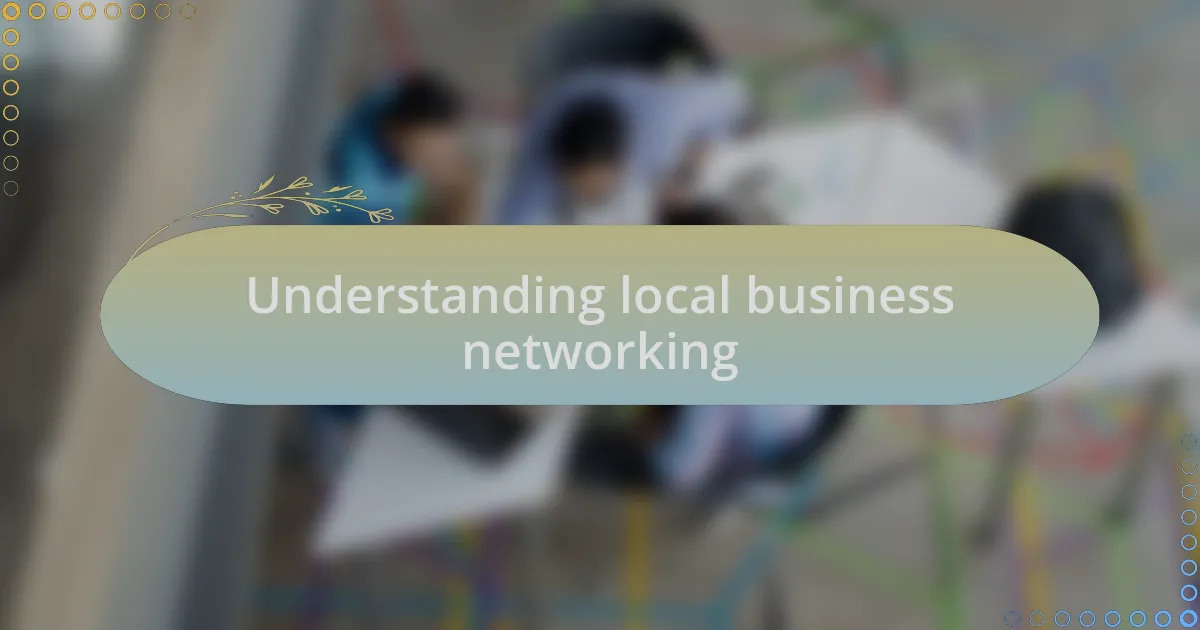
Understanding local business networking
Local business networking is more than just exchanging business cards; it’s building genuine relationships that can lead to collaborations and referrals. I remember attending a local networking event where I struck up a conversation with a shop owner who was struggling with customer engagement. Listening to their challenges made me realize how vital it is to support one another in our business journeys.
Have you ever walked away from a networking event feeling inspired? That happened to me when I met a fellow entrepreneur who shared their insights on leveraging social media for local visibility. It opened my eyes to the collective wisdom present within our community and reinforced the idea that networking is a two-way street—sharing knowledge and experiences can lead to mutual growth.
Understanding local business networking also means recognizing the unique dynamics of your community. For instance, I’ve found that connecting with local nonprofits can provide valuable resources and support, benefiting both my business and the community at large. It’s fascinating how these relationships can create a ripple effect, ultimately enriching the local economy and fostering a sense of camaraderie among businesses.
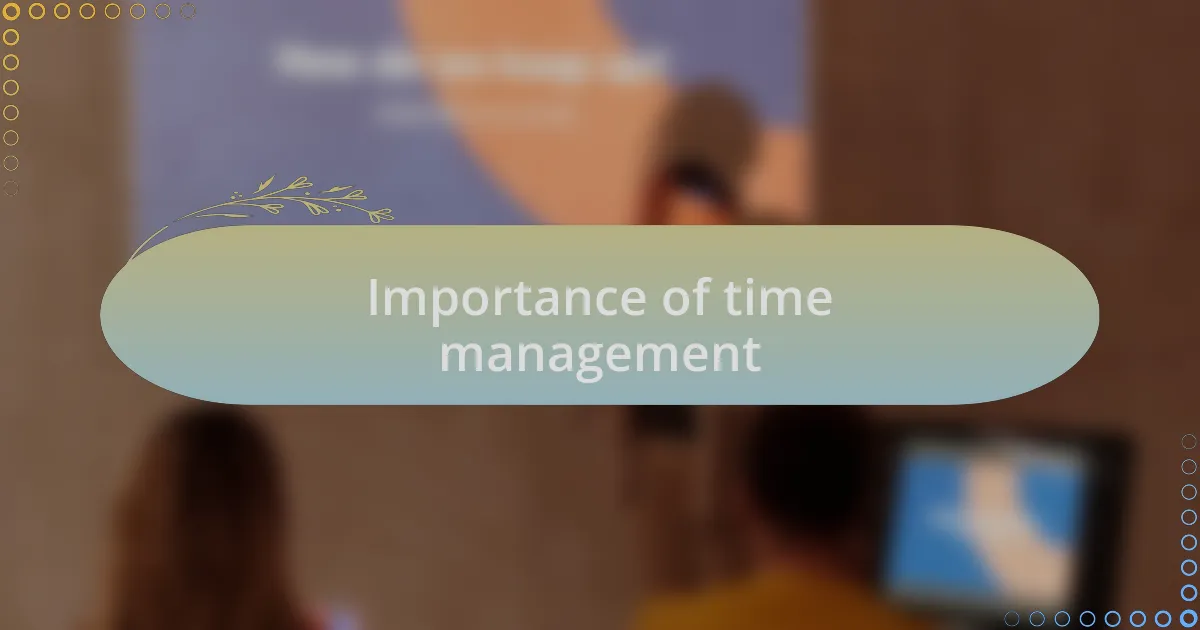
Importance of time management
Time management is essential for balancing the demands of running a local business while nurturing valuable networking relationships. I once found myself overwhelmed, juggling multiple projects and events, which made it hard to connect meaningfully with peers. I learned that prioritizing my time allowed me to fully engage with my networking circles, leading to deeper connections and better collaboration.
When I first embraced effective time management, I was amazed by how much I could accomplish in a day. I discovered that setting specific times to network, whether at events or casual meet-ups, helped me to be more intentional with my relationships. Have you ever felt rushed during a conversation? I realized that by managing my schedule better, I could provide my full attention, enriching both my experience and that of others I connected with.
Additionally, effective time management helps in planning and attending events that matter most to my business. One year, I committed to attending only those networking events that aligned with my goals, and the difference was remarkable. By focusing my efforts, I didn’t just save time; I also cultivated relationships that directly contributed to my business’s growth. How do you prioritize your time for networking? Taking intentional pauses to reflect on this could elevate your networking game significantly.
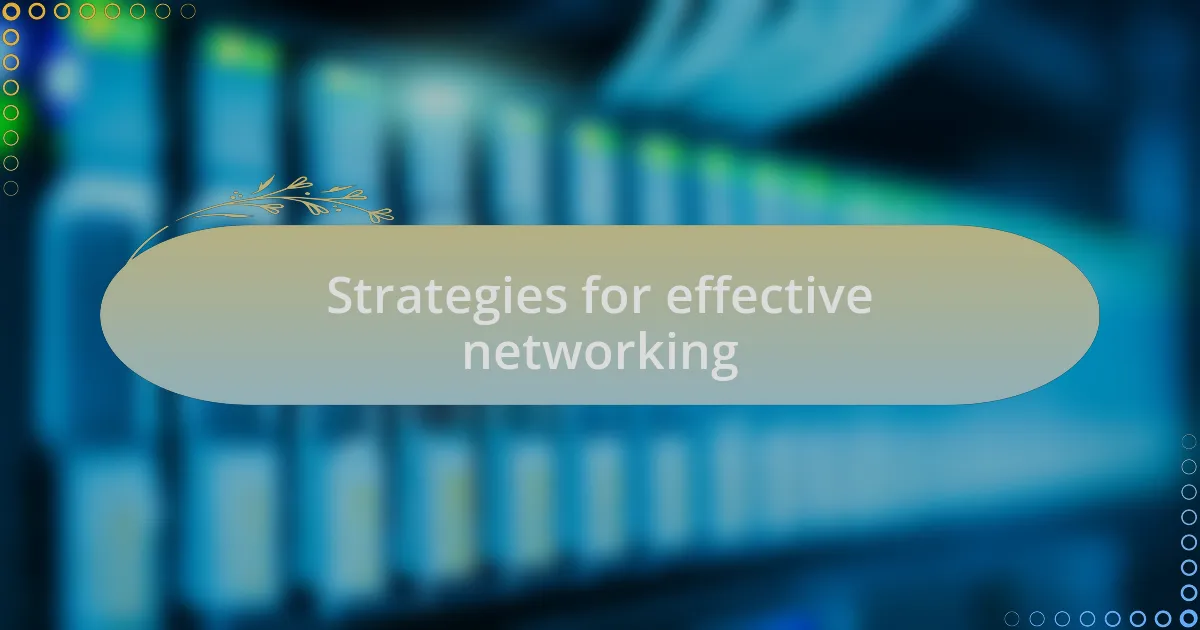
Strategies for effective networking
One strategy I’ve found incredibly effective is being selective about the networking events I attend. Early on, I would sign up for every possible event, hoping to meet everyone. This stretched me too thin and often left me feeling unfulfilled. Now, I carefully assess each opportunity, ensuring it aligns with my goals. It’s astonishing how quality trumps quantity; attending just a few meaningful events has vastly enriched my connections.
Engaging authentically with others is another strategy I’ve embraced. I remember a particularly impactful conversation with a fellow business owner who was facing similar challenges. Instead of skimming over small talk or rushing through pleasantries, I took the time to listen deeply and share my thoughts. This simple shift made the conversation memorable and laid the foundation for a lasting partnership. Have you ever felt a conversation truly resonate? That’s the kind of engagement I strive for, as it turns networking into collaboration.
Lastly, I’ve started setting clear follow-up goals after each networking experience. It could be as simple as sending a thank-you note or suggesting a coffee chat for further discussion. I recall connecting with someone at a local market, and after a follow-up message, we collaborated on a project that benefited both our businesses. It’s in those follow-ups that real relationships flourish. How often do you follow up with your contacts? That small effort can transform a fleeting meeting into a lasting connection.
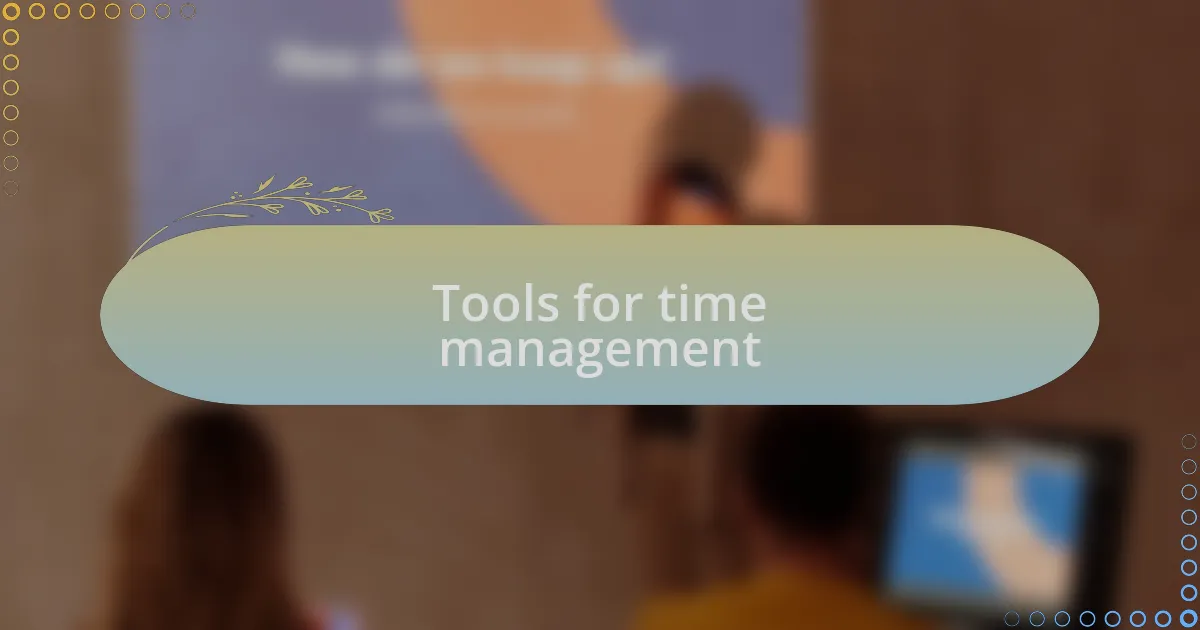
Tools for time management
In my journey toward effective time management, I’ve discovered various tools that truly enhance productivity. One of my go-to resources is a digital calendar. I used to rely on paper planners, but once I switched to Google Calendar, I realized the power of color-coding and reminders. It felt liberating to visualize my week at a glance and ensure I never missed important meetings. Have you ever experienced the peace of mind that comes from organized scheduling?
Task management apps have also played a significant role in my routine. I remember the chaos of juggling multiple projects with sticky notes scattered everywhere. Now, using Trello has streamlined my workflow; I can easily track progress and prioritize tasks. This tool has not only improved my efficiency but also reduced anxiety—knowing exactly what I need to tackle each day has been a game changer. Have you tried breaking down your tasks to feel less overwhelmed?
Lastly, I can’t emphasize enough the value of time-tracking software. Initially, I was skeptical, thinking it would add more stress. However, tools like Toggl transformed my perspective. By tracking where my time goes, I identified patterns that were wasting my efforts—like those seemingly harmless hours spent on social media. Now, I’m more mindful of how I allocate my time, which has led to heightened focus and productivity. How aware are you of your time usage?
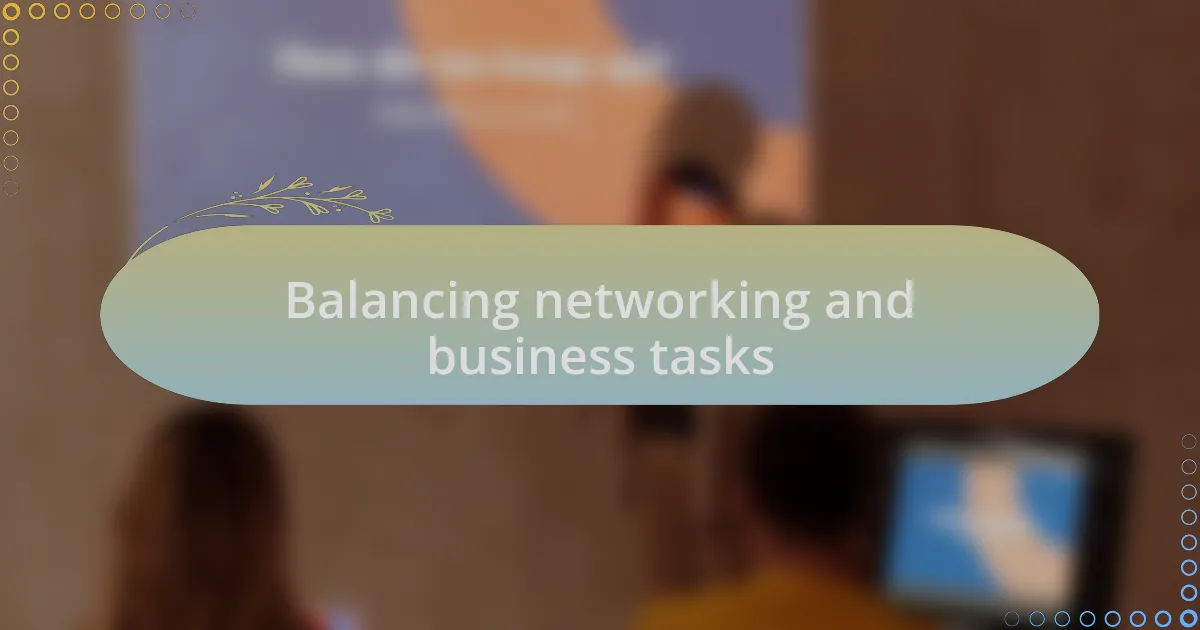
Balancing networking and business tasks
Balancing networking with business tasks can often feel like a juggling act. I recall those days when I’d attend networking events, filled with excitement, only to return to an overflowing inbox and unfinished projects. It became clear that setting boundaries was essential. I started scheduling specific blocks of time for networking activities, which let me enjoy those interactions without neglecting my business responsibilities. Have you ever had to enforce your own limits to find that balance?
I also learned to integrate networking into my daily routine rather than viewing it as a separate chore. For instance, during my lunch breaks, I began connecting with peers over coffee or a quick video call. It transformed a mundane task into a rewarding experience that nourished both my professional relationships and my business. Have you considered how small adjustments to your schedule can broaden your networking opportunities?
Ultimately, the key lies in prioritizing both aspects of your professional life. I developed a habit of reviewing my goals weekly, ensuring I allocated time for both networking and essential business tasks. It’s all about alignment—when you align your networking efforts with your business objectives, you not only make meaningful connections but also create pathways for growth. How do you ensure that your networking goals support your business ambitions?

Personal experiences with networking
Networking is not just about exchanging business cards; it’s also about forming genuine relationships. I vividly recall an event where I met someone who shared similar challenges in managing time effectively. Our conversation sparked not just a friendship but a collaboration that significantly helped in refining both our approaches to networking. Has a single interaction ever transformed your perspective?
There was a time when I hesitated to attend networking events because I feared they would disrupt my workflow. However, I challenged myself to view these gatherings differently. I approached them as opportunities for learning rather than just socializing. This change in mindset made things exciting. I realized that every conversation could yield new insights and potential solutions to my challenges. Have you ever thought about how shifting your perspective can redefine your networking experience?
I also found value in follow-up conversations after events. I remember sending a simple thank-you email to someone I had met, and it led to a series of discussions that subsequently enhanced both our businesses. It was a reminder that networking doesn’t stop at the event; it’s an ongoing process of nurturing connections. How often do you follow up after meeting someone new?
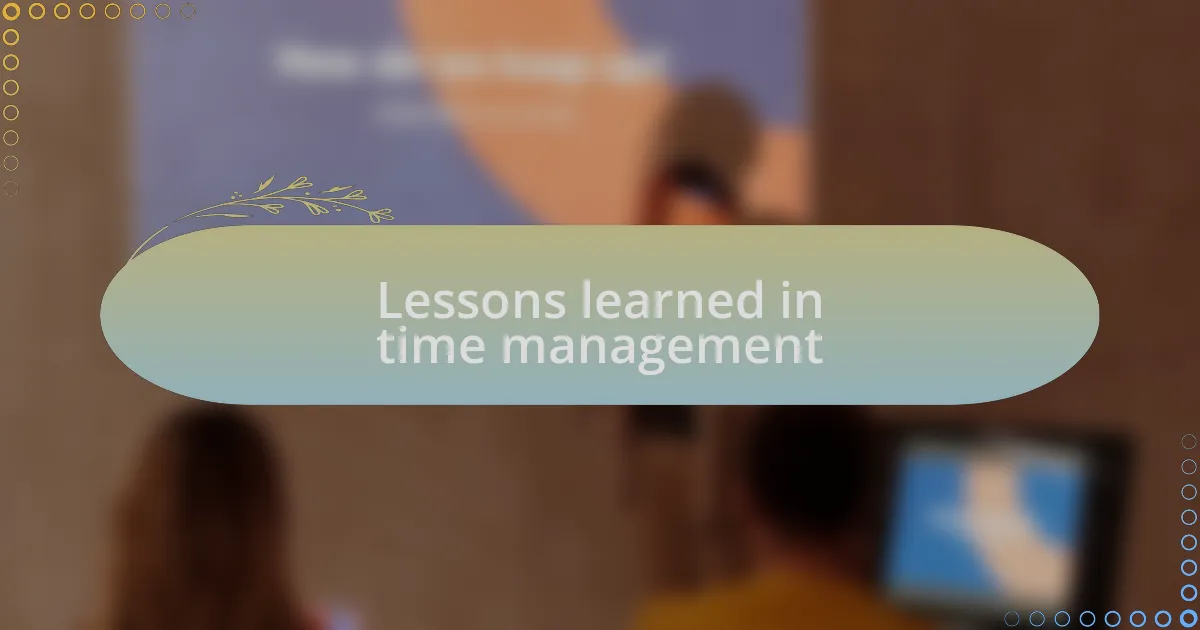
Lessons learned in time management
Reflecting on my time management journey, one of the pivotal lessons I’ve learned is the importance of prioritization. I once found myself drowning in tasks, only to realize that tackling less important jobs first was draining my energy. Now, I make it a habit to outline my top three priorities each day. Have you ever considered how focusing on key tasks can amplify your productivity?
Another significant insight has been the power of time blocks. In the past, I would attempt to multitask during networking events, trying to make connections while also managing messages on my phone. This split focus often left me feeling unfulfilled. When I started dedicating specific time blocks to networking, I felt more present and engaged. It’s amazing how a simple change in approach can lead to richer interactions. Can you think of moments where you’ve been distracted while meeting someone important?
Lastly, I’ve learned that effective time management also hinges on recognizing when to say no. There was a time when I felt obliged to attend every invitation, which sometimes backfired. By saying no to tasks that didn’t align with my goals, I found myself with more room to focus on the relationships that truly mattered. How often do you assess your commitments to ensure you’re investing time wisely?